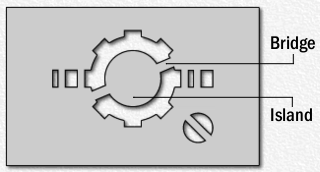
Back روسم Arabic Trafaret Azerbaijani Трафарэт Byelorussian Трафарэт BE-X-OLD Estergit Catalan Skabelon Danish Schablone German Στένσιλ Greek Stencilo Esperanto Estarcido Spanish




Stencilling produces an image or pattern on a surface by applying pigment to a surface through an intermediate object, with designed holes in the intermediate object. The holes allow the pigment to reach only some parts of the surface creating the design. The stencil is both the resulting image or pattern and the intermediate object; the context in which stencil is used makes clear which meaning is intended. In practice, the (object) stencil is usually a thin sheet of material, such as paper, plastic, wood or metal, with letters or a design cut from it, used to produce the letters or design on an underlying surface by applying pigment through the cut-out holes in the material.
The key advantage of a stencil is that it can be reused to repeatedly and rapidly produce the same letters or design. Although aerosol or painting stencils can be made for one-time use, typically they are made with the intention of being reused. To be reusable, they must remain intact after a design is produced and the stencil is removed from the work surface. With some designs, this is done by connecting stencil islands (sections of material that are inside cut-out "holes" in the stencil) to other parts of the stencil with bridges (narrow sections of material that are not cut out).
Stencil technique in visual art is also referred to as pochoir. A related technique (which has found applicability in some surrealist compositions) is aerography, in which spray-painting is done around a three-dimensional object to create a negative of the object instead of a positive of a stencil design. This technique was used in cave paintings dating to 10,000 BC, where human hands were used in painting handprint outlines among paintings of animals and other objects. The artist sprayed pigment around his hand by using a hollow bone, blown by mouth to direct a stream of pigment.
Screen printing also uses a stencil process, as does mimeography. The masters from which mimeographed pages are printed are often called "stencils". Stencils can be made with one or many colour layers using different techniques, with most stencils designed to be applied as solid colours. During screen printing and mimeography, the images for stenciling are broken down into color layers. Multiple layers of stencils are used on the same surface to produce multi-colored images.